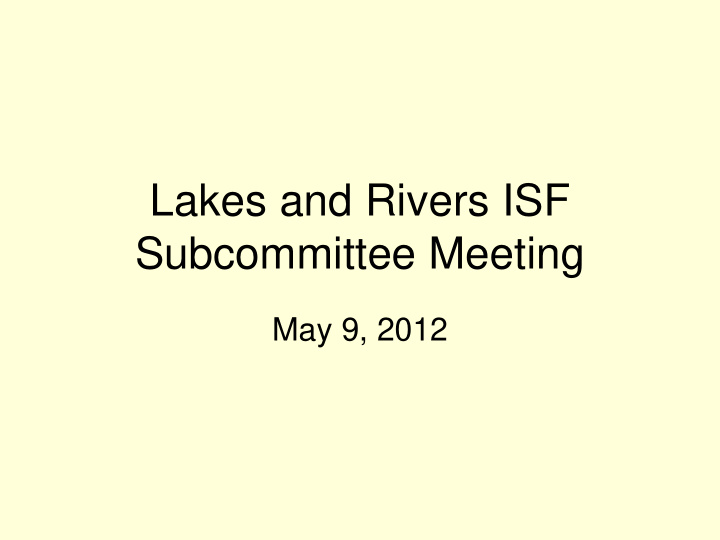



Lakes and Rivers ISF Subcommittee Meeting May 9, 2012
Goals • 2013: ISF Program report to the GC • To identify specific water quality and water resource use concerns/objectives • To reach a joint recommendation concerning balancing and coordinating water resources management plans affecting lake levels and river flows
The players: Lake Interests River Interests Water Users
Water Use vs. Water Availability - Time of Year is important
Water Use vs. Water Availability - Time of Year is important
Lamprey River flow changes from Pawtuckaway Lake and Mendums Pond storage and release operations Lam prey River Monthly Median of Mean Flow (1934 to 2004) 700 Median (1934-1954) Median (1955-2004) 600 Developm ent / Urbanization E ffects (e.g. impervious areas, w etland filling) 500 ) s f c ( w 400 o l F n a e M o f n a 300 d i e M Impoundment Release 200 Impoundm ent Retention 100 0 Jan Feb Mar Apr May Jun Jul Aug Sep Oct Nov Dec Month
Other factors effecting flow: • Land use/development • Riprap and undersized culverts/bridges • Impervious surfaces • Floodplain development • Loss of riparian buffers • It’s not just the water users…
Following recent rains
Still low even with more rain
ISF Program assumption: full pool is achieved after spring melt Do we continue large fall drawdowns?
2012 A’ A
2006
Pawtuckaway Lake Drowns Dam
Pawtuckaway Lake Drowns Dam
Pawtuckaway Lake outflow April 24, 2012 ~0.002 cfsm (essentially no outflow to the North River)
Pawtuckaway Lake Dollof Dam
Watersheds are not towns • Political representation is by political boundaries, not watersheds • Watershed development – affects flow timing and magnitude – stream flow changes are not just water users, but land uses, too
Flow Management • Water Management Plans under ISF – Conservation Plan • Reduce waste and water losses – Water Use Management Plan • Spread, flatten and reduce withdrawal impacts – Dam Management Plan • Reset flow patterns using dam releases
Application of management • Conservation plans – Ongoing assessment and response • Water Use Plans – Response to low flow conditions • Dam Management Plans – Water use plans operating—still need flow pattern adjustment
Other mechanisms? • Inclining rate structures • Infrastructure – return water to withdrawal point • Other?
Rivers and Lakes Legislation • Both programs aspire to water quality – If conflicts arise in the attempt to protect the valued characteristics of a lake/river, priority shall be given to those characteristics that are necessary to meet state water quality standards. – [lake/river] program[s] shall complement and reinforce existing state and federal water quality laws
ISF Program’s water quality protections for lakes - current pilot program - • Using draft guidance limiting lake level fluctuations • Coordinating management with NH F&G re: loons, fish, safety, recreation • Coordinating with NH DRED state parks on recreation
Management scenarios will vary due to availability of manageable storage: • Examples: – Winnipesaukee/Merrimack DRs – Lamprey DR – some large impoundments – Souhegan DR – several small impoundments – Swift DR – no impoundments Tiered Approach: What is the priority between: conservation practices, water users, and dam management (aka storage)?
Scenario - Swift • Swift – Conservation always operating – Water use – no surface water withdrawals when flows drop below protected threshold; few water users; expanded use of storage/alternate sources required • Exceptions: de minimis withdrawals – Dams – none exist; what other options might apply?
Scenario - Lamprey • Lamprey – Conservation always operating – Water use – no surface water withdrawals when flows drop below protected threshold • Exceptions: de minimis withdrawal; use of storage – Dam – after other management; expect little effect on impoundments, but recreational
Scenario - Souhegan • Souhegan – Conservation always operating – Water use – no surface water withdrawals when flows drop below protected threshold; alternative sources required • Exceptions: de minimis withdrawals – Dam – after other management; expect moderate effects on impoundments and may limit the number of management events, but fewer events expected; flood control and hydropower
Scenario – Winnipesaukee/Merrimack DRs • Merrimack DRs (includes Winnipesaukee) – Conservation always operating – Water use – no surface water withdrawals when flows drop below protected threshold • Exceptions: de minimis withdrawal; use of storage – Dam – after other management; expect little effect on impoundments;
Water Quality is the Driving Factor • Lake levels are a factor in water quality standards (littoral zone ecology) • Lake level changes can range from natural to large scale ‘artificial’ • The impacts on water quality values from lake level change can vary from “minimal’ to “very significant” • Lakes effect downstream stream flow – naturally and/or ‘artificially’ • Limited lake level changes for river ecosystem health can be appropriate • Artificial lake level changes can impact downstream water quality values
Decisions to be made • How do we define the subset of artificial lake level changes that may impact instream flow water quality (chemical and/or biological)? • What are the appropriate conditions to limit artificial lake level changes when they impact downstream water quality values? • What are the appropriate conditions to use lake level management to improve downstream water quality?
Recommend
More recommend